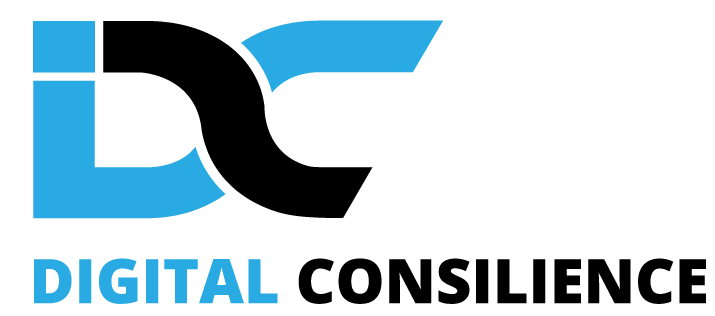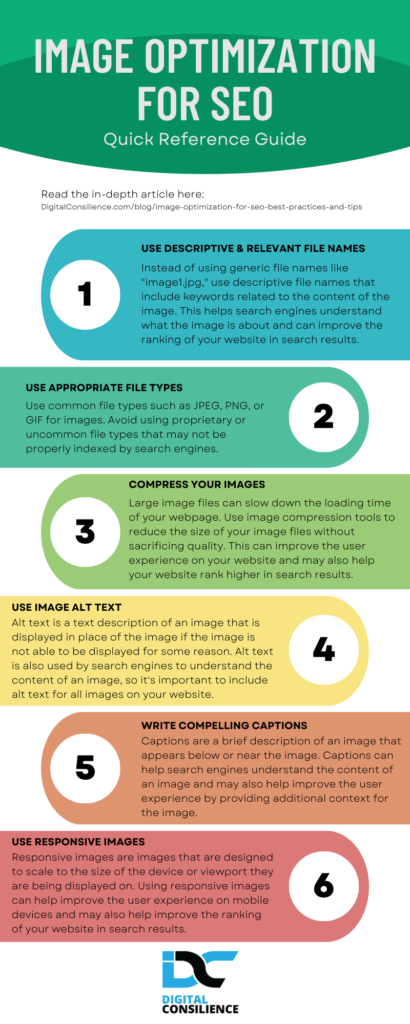Learn the best practices and tips to optimize your images for search engines: file names & types, compression, alt text, captions, and responsiveness.
No matter your industry or the purpose of your website, optimizing images for search engines is an important aspect of search engine optimization (SEO) that is often overlooked. Properly optimized images can be a low-hanging fruit that can be harvested to improve the user experience on your website, can help your website rank higher in search results and lead to more conversions.
Here are some best practices for optimizing images for search engines:
1. Use Descriptive, Relevant File Names
Using descriptive and relevant file names for images is important for search engine optimization (SEO) because it helps search engines understand the content of the images on your website. When search engines crawl your website, they use the file names of your images as one of the signals to determine the content of your website.
By using descriptive and relevant file names for your images, you can give search engines more information about the content of your images, which can help your website rank higher in search results for relevant keywords. For example, if you have an image of a red sports car on your website, using a file name like “red-sports-car.jpg” would be more descriptive and relevant than using a file name like “image1.jpg.”
Using descriptive and relevant file names can also improve the user experience on your website by providing context and information about the images to users. When users see descriptive and relevant file names, they may be more likely to understand the content of the images and may be more interested in interacting with them.
Overall, using descriptive and relevant file names for images is an important aspect of SEO and can help improve the ranking of your website in search results and the user experience on your website.
2. Use Appropriate File Types
There are several common image file types that can be used on the web, including JPEG, PNG, and GIF; as well as a relative newcomer, Webp. Each of these file types has its own advantages and disadvantages, and the best file type to use may depend on the specific needs of your website.
JPEG (Joint Photographic Experts Group) is a commonly used file type for photographs and images with a lot of detail. JPEGs support a wide range of colors and can be saved at a variety of quality levels, allowing you to balance image quality with file size. However, JPEGs are not ideal for images with sharp edges or large areas of solid color, as they may appear pixelated or blurry.
PNG (Portable Network Graphics) is a file type that is commonly used for images with transparent backgrounds, such as logos or icons. PNGs support a wide range of colors and can be saved at a variety of quality levels, similar to JPEGs. However, PNGs are not as efficient as JPEGs at compressing images, so they may result in larger file sizes.
GIF (Graphics Interchange Format) is a file type that is commonly used for simple graphics and images with a limited number of colors. GIFs support transparency and can be saved in an animated format, making them useful for creating simple animations. However, GIFs are not ideal for photographs or images with a lot of detail, as they only support a limited number of colors.
WebP is an image file format developed by Google that is designed to provide superior image quality and smaller file sizes compared to other image file formats. WebP supports both lossy and lossless compression, allowing you to balance image quality with file size.
WebP is a good choice for use on websites and for search engine optimization (SEO) because it can significantly reduce the size of your image files without sacrificing quality. This can help improve the loading speed of your website, which is an important factor for both SEO and the user experience.
WebP is also supported by a wide range of web browsers, including Google Chrome, Mozilla Firefox, and Microsoft Edge. However, WebP is not natively supported by all web browsers, so you may need to use a fallback option for browsers that do not support WebP.
Ultimately, when choosing an image file type for your website, it’s important to consider the needs of your website and the characteristics of the image. Optimizing images for search engines and the user experience also involves using appropriate file sizes and compressing images to reduce loading times.
3. Compress Your Images
Compressing images is important for search engine optimization (SEO) because it can help improve the loading speed of your website. Search engines use website loading speed as a ranking factor, so a faster loading website may rank higher in search results. In addition, users tend to prefer faster loading websites and may be more likely to stay on a website that loads quickly.
There are several methods available for compressing images:
- Lossy compression: This method involves reducing the size of an image by removing some of the data from the image. Lossy compression can significantly reduce the size of an image, but it may also result in a loss of image quality.
- Lossless compression: This method involves reducing the size of an image by removing redundant or unnecessary data from the image, without affecting the quality of the image. Lossless compression can reduce the size of an image, but the reduction may not be as significant as with lossy compression.
- Vector graphics: Vector graphics use mathematical formulas to describe images, rather than pixels. Vector graphics can be scaled to any size without losing quality, and they tend to have smaller file sizes than raster images.
There are a variety of tools available for compressing images, including online image compression tools, image editing software, and plugins for web browsers. Some common image compression tools include TinyPNG, Kraken.io, and Compressor.io.
Overall, compressing images is an important aspect of SEO because it can help improve the loading speed of your website and provide a better user experience. By using appropriate methods and tools to compress images, you can reduce the size of your image files and improve the performance of your website.
4. Use Image Alt Text
Alt text (alternative text) is a text description of an image that is displayed in place of the image if the image is not able to be displayed for some reason. Alt text is important for search engine optimization (SEO) because it helps search engines understand the content of an image and can also improve the accessibility of your website for users with disabilities.
Here are some best practices for writing alt text:
- Keep it short and concise: Alt text should be brief and to the point, usually no longer than a few words.
- Use relevant keywords: Include relevant keywords in the alt text that accurately describe the content of the image.
- Avoid using generic phrases: Avoid using generic phrases like “image” or “picture” in the alt text, as they don’t provide any information about the content of the image.
- Don’t stuff keywords: Avoid stuffing too many keywords into the alt text, as this may not accurately describe the content of the image and may be seen as spammy by search engines.
- Make it descriptive: Make the alt text descriptive and informative, as it will be used by search engines to understand the content of the image.
By following these best practices for writing alt text, you can help search engines understand the content of your images and improve the accessibility of your website for users with disabilities. Alt text is an important aspect of SEO and should be included for all images on your website.
5. Write Compelling Image captions
Image captions are brief descriptions of an image that appear below or near the image. Using image captions is important for search engine optimization (SEO) and the user experience because they can provide additional context and information about the image to search engines and users.
Here are some best practices for writing image captions:
- Keep it short and concise: Image captions should be brief and to the point, usually no longer than a few words.
- Use relevant keywords: Include relevant keywords in the caption that accurately describe the content of the image.
- Avoid using generic phrases: Avoid using generic phrases like “image” or “picture” in the caption, as they don’t provide any information about the content of the image.
- Make it descriptive: Make the caption descriptive and informative, as it will be used by search engines to understand the content of the image and may also provide additional context for users.
- Use proper grammar and spelling: Make sure the caption is well written and free of spelling and grammar errors.
By following these best practices for writing image captions, you can help search engines understand the content of your images and provide additional context and information for users. Image captions are an important aspect of SEO and can improve the ranking of your website in search results and the user experience on your website.
6. Use Responsive Images
Using responsive images is important for search engine optimization (SEO) and the user experience because it allows images to scale to the size of the device or viewport they are being displayed on. This can improve the user experience on mobile devices, as well as on devices with different screen sizes and resolutions.
Responsive images are particularly important for SEO because they can improve the loading speed of your website on mobile devices. Mobile devices often have slower internet connections than desktop computers, so it’s important to optimize the loading speed of your website for mobile devices to improve the ranking of your website in search results.
There are several ways to implement responsive images on your website, including using the “srcset” attribute in the “img” tag and using the “picture” element. You can also use responsive image frameworks, such as the “picturefill” library, to automatically resize images on your website.
Overall, using responsive images is an important aspect of SEO and the user experience because it allows images to scale to the size of the device or viewport they are being displayed on, improving the loading speed of your website on mobile devices and providing a better user experience for your website visitors.
By following these best practices for optimizing images, you can improve the ranking of your website in search results and provide a better user experience for your website visitors.
Lance Harrell – Owner/SEO Specialist

